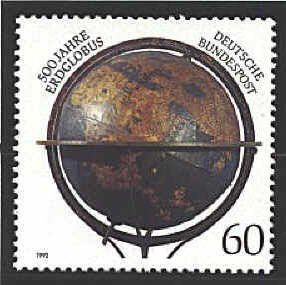|
Martin Behaim ~ 1492
Terrestrial and celestial
globes are used for representing the positions of geographical and
astronomical features. During the sixteenth century, with the new
interest in exploration and navigation, terriestrial globes became
increasingly in demand.
The first known terrestrial globe was
constructed by the Nuremberg map-maker Martin Behaim in 1492. (For
more information on this globe see under "Historical Maps.")

Arabian Celestial Globe ~ 1279
"The
Arabian celestial globe of 1279 is one of the five oldest Islamic
globes known. Constructed by Muhammed be mu'aijad al-Ardi of Meragha
in Persia, it consists of brass overlaid with gold and silver. Only
30.5 cm high with a diameter of 14.4 cm, it illustrates the positions
of about one thousand stars arranged into 47 constellations, following
ideas of Ptolemy."
Robin J. Wilson, Stamping through Mathematics,
Springer-Verlag, 2001, p. 40

Praetorius ~ 1568
"The
terrrestrial globe of 1568 was constructed by Johannes Praetorius of
Nuremberg. It is made of brass to a scale of about 1 to 45 million,
and is 47 cm high with a diameter of 28 cm. The map inscribed on the
globe depicts the continents of Europe, Africa, Asia and America, with
America shown joined to Asia."
Robin Cook, Loc cit.


 |
